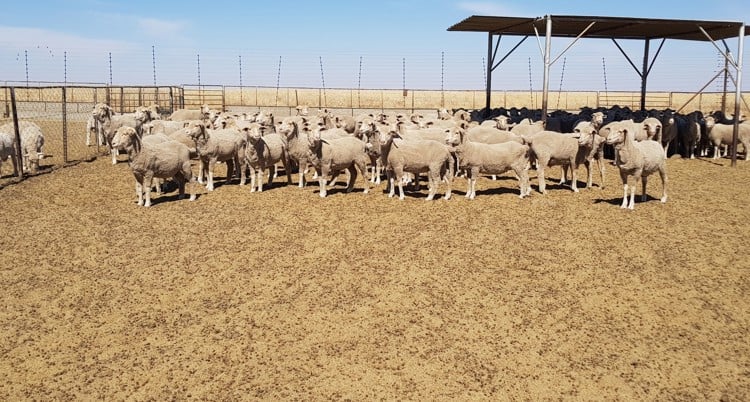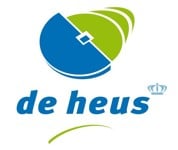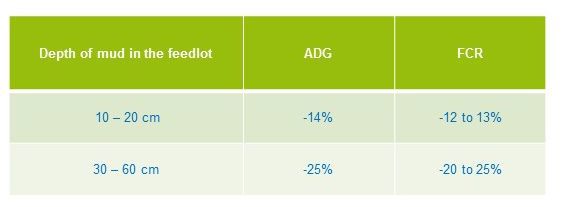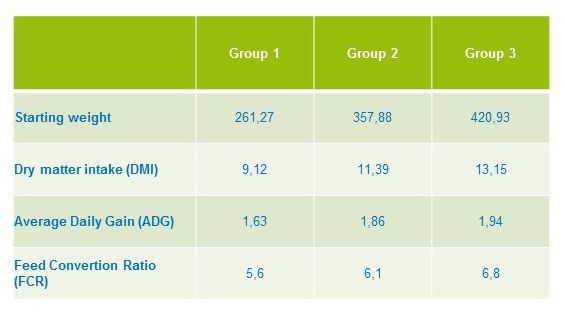Factors that determine the effectiveness of feeding in sheep and cattle feedlots
The average daily gain (ADG) is a norm that are used most commonly to measure feed performance in feedlots. The two most important factors that have the greatest effect on the profitability of a feedlot are dressing percentage and feed efficiency. Feed efficiency or feed conversion ratio (FCR) is calculated by the amount of dry matter that cattle consume in relation to their daily weight gain.

The factors that influence FCR can be divided into several categories:
Environmental Factors:
- Mud in the Feedlot
Mud can have a major influence on the ADG and FCR of animals in a feedlot. Animals housed in muddy conditions consume more energy. Thus, less energy is available for growth. Muddy conditions near feeders also discourage cattle to eat, leading to reduced intake and decreased performance. The effect of mud in the feedlot on growth and FCR (as described by Bruce, 1984) is shown in Table 1.
Table 1: The Effect of Mud Depth on ADG and FCR in a Cattle Feedlot (Bruce, 1984, South Dakota State University
It is therefore important to build feedlots on a slope to ensure good drainage. During the rainy season the number of animals per feedlot can also be reduced to control the mud in the feedlot.
- Temperature and Humidity
The temperature humidity index (THI) is a measurement used since the early 1990s. It represents the combined effects of ambient temperature and relative humidity, and is a useful and easy way to assess the risk of heat stress. Cattle's thermally neutral zone is between 15°C and 25°C, although it varies between different breeds. The effect of heat stress can be reduced by moving the feeding sessions to the cooler times of the day. Enough fresh water and shade will also have a positive influence on feed intake. When the day temperatures rise above 27°C, cattle drink up to 7,5 ℓ water per 45 kg of their body mass. A calf with a mass of 400 kg will therefore drink about 66 ℓ of water.
Animal Factors
- The Body Condition of Animals
The condition of cattle when they enter the feedlot can affect the effectiveness of feed. Most research indicates that cattle that are slightly underconditioned will initially have compensatory growth on a high-energy feed supply. This compensatory growth can increase feed efficiency by 5 - 10% in the first 60 days of nutrition. Cattle that are over-conditioned have increased maintenance needs and a decreased feed efficiency.
- Carcass Grading
If cattle are fed for too long, or beyond their ideal market weight, and gain too much fat, this will significantly reduce the FCR. Less feed is required to lay down muscle mass than to gain the same weight in fat. The ideal slaughter animal must have an A2 carcass rating.
- Age
The age of calves also affects their FCR. In trials by Adams et al. (Effects of Sorting Steers by Body Weight into Calf-fed, Summer Yearling, and Fall Yearling Feeding Systems: Prof. Anim. Sci. 26: 587-594) it was shown that calves that started directly after weaning had the best feed efficiency.
- Gender
The purchase price of bull calves is usually higher than that of heifers. Bull calves grow on average 8 to 10 per cent faster than heifers with a 6 to 8 percent better FCR. Heifers are less effective because they have a lighter adult weight. The profitability of bull calves in the feedlot is therefore higher.
-
- Breed
As a rule, European breeds have a better FCR than the Zebu type breeds, but there can be just as much variation within a breed as between breeds.
Nutrition
- The Relationship between Roughage and Concentrated Feed in the RationHigher levels of concentrated feed in relation to roughage in a feedlot lamb ration will improve the FCR compared to a more conservative roughage based diet. Adaptation from a roughage based diet to a grain based diet (compound feed) is very important. If animals are not adequately adapted, the risk of rumen-acidosis increases. Animals with rumen-acidosis have a lower DMI and ADG. In general, increased levels of roughage in the ration will adversely affect feed conversion, while on the other hand, reducing the cost of the ration and the key to optimum profitability lies in the balance between the two components. In most cases, increased feed efficiency has higher profitability.
-
- The Processing of Grain
Grain processing can also improve feed efficiency and overall profitability. Maize, which is mostly used as a source of energy in feedlots, is more digestible if it is ground or cracked. However, the costs associated with processing may not always be economical, as the additional cost thereof are sometimes not covered by the improved performance.
- Protein
Adhering to the protein requirements of cattle in feedlots can have a huge effect on the improvement of feed efficiency. Young growing animals in the feedlot require higher levels of protein (13 - 15%) than older animals (11 - 13%), as younger animals require more muscle deposition compared to the older animals.
Feed Additives and Implants
Feed additives and implants are commonly used in the meat production sector. These have brought significant improvements in feed efficiency.
Some of the Additives that can be used to Improve Feed Conversion Ratio include:
An Ionofore has the ability to change the composition of rumen bacterial population and leads to improved rumen fermentation. Ionophores also play a role in the prevention of acidosis. By including ionophores in the feed, the FCR of the feed increase by 6 - 12%. The most common ionophore used in feedlot rations is Monensin.
- Ionophores
An Ionofore has the ability to change the composition of rumen bacterial population and leads to improved rumen fermentation. Ionophores also play a role in the prevention of acidosis. By including ionophores in the feed, the FCR of the feed increase by 6 - 12%. The most common ionophore used in feedlot rations is Monensin.
- Beta-agonists
Beta-agonists is the other important additive that can be fed to cattle at the end of the feeding period to increase carcass weight, thereby improving the efficiency of the feed. At a live weight, there is no dramatic improvement in feed efficiency, but in terms of the final carcass weight, there is.
- Implants
Implants contain natural or synthetic compounds that work in the same way as hormones. Generally, the use of ear implants, increases ADG by 10 - 15% and it increases the FCR by 8 - 12%. Nutrition must be adapted according to the type of implants that are used.
All of the above-mentioned elements have an influence on the animal's performance in the feedlot. By managing the nutritional, animal and environmental factors, the profitability of the feedlot can be improved.


